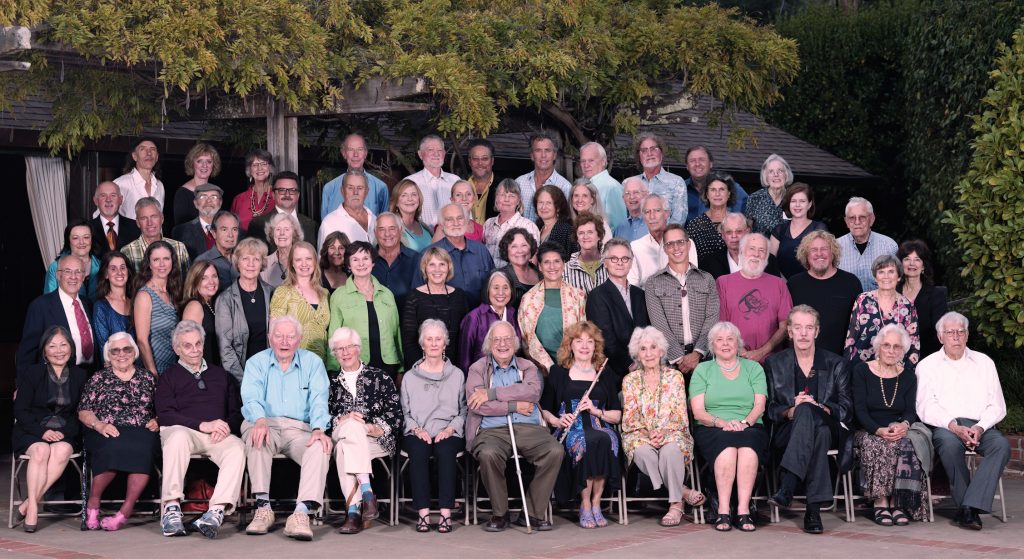History
1987
In 1987, Abby Wasserman, a Mill Valley Arts Commissioner and native of Mill Valley, suggested that the Commission start an award recognizing lifetime achievement in the arts. The Commission agreed, and in 1988 Ann O’Hanlon , founder of Sight & Insight Art Center (now the O’Hanlon Center for the Arts), was given the first Creative Achievement Award.
The next year, as Abby was serving as Commission Chair, Bob Greenwood, longtime conductor and music teacher at Tamalpais High School, was the recipient. After this, the Arts Commission recognized one outstanding person in the arts once a year: Leah Schwartz, Don Carpenter, Mark Fishkin. The award was always a hand-calligraphed certificate presented by the City Council at a council meeting; and often the audience and recipient had to wait for their moment for a break in council proceedings.
1994
By 1994, it became apparent that Mill Valley had too many talented people to limit the selection to just one person per year. Trubee Schock, who had served on the Arts Commission with Abby, and who had experience organizing other large awards dinners, invited Abby and several present and former arts commissioners, including Bob Greenwood, to join her in creating a broader and more elegant way to honor the truly creative and talented people in our community. The group, meeting at former Mayor Alison Ruedy‘s house, was enthusiastic, and a second meeting was called to revise the concept.
Over the next 16 months, they refined the concept and planned the first Milley Awards. Among those who brainstormed around Ruedy’s dining room table with Trubee and Abby were Val Binns, Bob Greenwood, Connie Kroeck, Anne Neely, and Queenie Taylor. The name for the award, “The Milley,” was Greenwood’s idea.
In the course of those months, the concept of the Creative Achievement Award was reconceived to become a larger and grander event, with more public involvement. The Committee decided to honor up to five people per year in different disciplines, with certain criteria being established, including alternating judges and nominating guidelines. The revamped award, The Milley Award for Creative Achievement, was launched in 1995 at an awards dinner at The Outdoor Art Club. From that first year, most “Milleys” event were sold out. Each year the initial Creative Achievement recipients have joined that year’s new Milley recipients during the Ceremonial Dinner.
The award is a bronze statuette designed and crafted by John Libberton, Sausalito sculptor, on an engraved pedestal. The award has come a long way from a certificate in City Hall!
As the years passed, two more awards were added as a way to recognize those who contributed to the arts in Mill Valley in other ways. The Executive Committee selects the recipients for these awards.
2000
In 2000 the Sali Lieberman Award, named for the initial founder of the Marin Theater Company, was created by the Milley Executive Committee to honor lifetime achievements of those who embody Sali’s inspiration, courage and determination; and who, like Sali, make a lasting contribution to the cultural life of our community. More info about Sali.
In 2002 the Vera Schultz Award was created to honor achievements of organizations which embody her activism, leadership, courage and vision, and which, like Vera, have made lasting contributions to the cultural life of our community. More info about Vera.
2004
In October 2004, the Milley Awards commemorated its tenth year with a special Tenth Anniversary gathering at the awards ceremony.
| Front Row (L-R): | Catherine Angelo, Phil Fath, Josepha Fath, Jon Fromer, David Roche, Jeanie Chandler, Charles Meacham, Pirkle Jones, Millicent Tomkins, Zilpha Keatley Snyder, Allester Dillon, Richard Dillon and Katharine Mills |
| Second Row (L-R): | Tony Angelo, Carol Cunningham, Joe Angiulo, Cece Bechelli, Leah Schwartz, Joan Deamer, David Fromer, Jacki Fromer, Rosemary Ishii MacConnell, Trisha Garlock, Susan Trott, Marilyn Smith, Phyllis Faber, Lettie Connell Schubert, Mark Fishkin, Jeanne Patterson and Edward “Ned” Mills |
| Back Row (L-R): | Dan Caldwell, Barry Spitz, Michael Parra, Steve Coleman, Dick Jessup, Reed Fromer, Jan Pedersen Schiff, (sculptor) John Libberton, Bob Greenwood, Rita Abrams, Paul Liberatore, Tom Killion, George Leonard and Chester Arnold |
2014
In October 2014, the Milley Awards celebrated its 20th Anniversary with a special gathering at the Outdoor Art Club in Mill Valley. All past award recipients and Committee members were invited to commemorate the milestone, and a group photo composed of 65 Milley honorees was taken.
| Front Row (L-R): | Rosemary Ishii MacConnell, Kett Zegart, Mort Sahl, Bob Greenwood, Phyllis Faber, Gretchen Mentzer, Phil Fath, Jeanie Chandler, Naomi Newman, Millicent Tomkins, Dan Hicks, Gabriella Mautner and Richard Moore |
| Second Row (L-R): | Joe Angiulo, Josepha Fath, Erma Murphy, Ann Killion, Lucy Mercer, Megan Wilkinson (For Ann O’Hanlon), Ricca Wolff, Joan Deamer, Jean Shinoda Bolen, Lonnie Barbach, Craig Frazier, Scott Mathews, John Goddard, Sammy Hager, Betty Goerke and Rita Abrams |
| Third Row (L-R): | Catherine Angelo, Tom Killion. Martin Cruz Smith, Susan Trott, Jacki Fromer, Dave Fromer, Eldon Beck, Trisha Garlock, Zoë Elton, Alan Nayer, Chris Raker and (sculptor) John Libberton |
| Fourth Row (L-R): | Tony Angelo, Phil Sheridan, Ben Cleaveland, Will Marchetti, Susan Brashear, Jan Pedersen Schiff, Kristin Jakob, Jane Hirshfield, Katy Butler, Steve McNamara, Laurie Cohen and Cece Bechelli |
| Fifth Row (L-R): | Steve Coleman, Sue Carlomagno, Abby Wasserman, Barry Spitz, Ivan Poutiatine, Daniel Patrick, Jimmy Dillon, Austin deLone, Steve Bajor, Reed Fromer and Trubee Schock |
The Marin Independent Journal announced the anniversary, and Paul Liberatore wrote, “In the beginning, there was some concern that by giving out five Milleys a year, Mill Valley would run out of people to honor. Two decades later, that is no longer a worry.”
“We’ve proven that we’ll never run out of artists,” Abby Wasserman said. “Not in Mill Valley. It’s astounding.”



